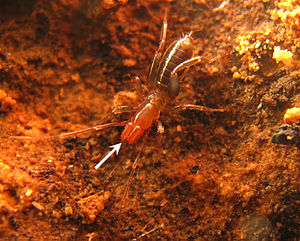Rowlandius potiguar
| Rowlandius potiguar | ||||||||||||
|---|---|---|---|---|---|---|---|---|---|---|---|---|

Rowlandius potiguar , female |
||||||||||||
| Systematics | ||||||||||||
|
||||||||||||
| Scientific name | ||||||||||||
| Rowlandius potiguar | ||||||||||||
| Santos , Ferreira & Buzatto , 2013 |
Rowlandius potiguar is a reddish-brown, a few millimeters large scourge scorpion from the subordination of the dwarf scourge scorpions (Schizomida). It was discovered in several caves in northeastern Brazil by a team led by Adalberto Santos and described in 2013.
features
The description of the species was based on several males and females of the species that come from different caves. The holotype , a male, has a total length of 3.58 millimeters. The prosoma is 1.55 millimeters long, the opisthosoma 2.03 millimeters long. The propeltidium , which covers parts of the prosoma and the anterior segments of the opisthosoma, was 1.09 millimeters long and 0.64 millimeters wide. The female described as a paratype is slightly larger with a total length of 4.17 millimeters, 1.7 millimeters are accounted for by the prosoma and 2.47 millimeters by the opisthosoma, the propeltidium is 1.14 millimeters long.
The prosoma of the male, the pedipalp and the first pair of legs are red-brown and the opisthosoma, the chelicerae and the rear pairs of legs are greenish-brown. The Propeltidium has an anterior and a posterior pair of bristles. In females, the prosoma, the pedipalp and the first pair of legs are red-brown. The almost circular eye spots are only indistinctly developed. The tergites I to IX of the opisthosoma each have a dorsal pair of bristles, the tergites X and XI have two lateral pairs of bristles and a ventral series of five bristles. The segments XI and XII are designed telescopically. The fixed finger of the Chelicere in the male has seven teeth, of which the ventral one is the longest. The movable finger has only indistinct teeth. In females, the flagellum has four segments.
Within the males of the species, the size of the pronounced pedipalps of the males varies considerably. These can be the same size as the females, but in many males they are three times the length. The males are divided into two groups according to the length of the pedipalps, which are referred to as homeomorphic (with the same length as the females) and heteromorphic (with larger pedipalps).
Further characteristics concern the bristling of the limbs and the flagellum as well as the proportions of the individual limb lengths of the limbs.
Habitat and way of life

The species was discovered by researchers in several limestone caves in the Brazilian state of Rio Grande do Norte . Since there are also bats in all of the caves , the researchers suspect that the animals feed on small insects that live in the bat droppings.
The animals are adapted to life in caves, but the reduction of the eyes does not necessarily imply a cave adaptation, since the absence of such organs is not a special feature of pygmy whip scorpions and visual orientation also plays a subordinate role in other, non-troglobiont species.
Systematics
Rowlandius potiguar was described as a separate species together with Rowlandius ubajara in 2013 by a research group led by Adalberto Santos from the Federal University of Minas Gerais . Both species were classified in the genus Rowlandius described in 1995 , which consists of 54 known species and is mainly found on the islands of the Caribbean .
The name of the species is derived from the name Potiguar for the inhabitants of the Brazilian state of Rio Grande do Norte.
Individual evidence
- ↑ a b c d e Adalberto J. Santos, Rodrigo Lopes Ferreira, Bruno A. Buzatto: Two New Cave-Dwelling Species of the Short-Tailed Whipscorpion Genus Rowlandius (Arachnida: Schizomida: Hubbardiidae) from Northeastern Brazil, with Comments on Male Dimorphism . PLoS ONE 8, 5, e63616, 2013 doi: 10.1371 / journal.pone.0063616
literature
- Adalberto J. Santos, Rodrigo Lopes Ferreira, Bruno A. Buzatto: Two New Cave-Dwelling Species of the Short-Tailed Whipscorpion Genus Rowlandius (Arachnida: Schizomida: Hubbardiidae) from Northeastern Brazil, with Comments on Male Dimorphism. PLoS ONE 8, 5, e63616, 2013 doi: 10.1371 / journal.pone.0063616
